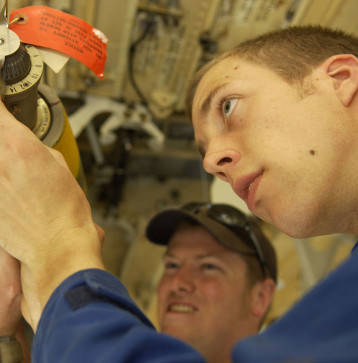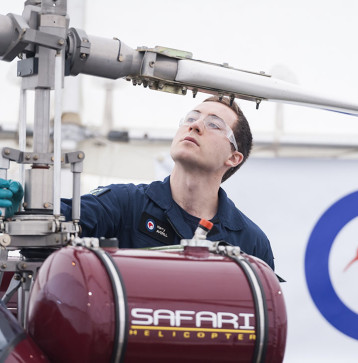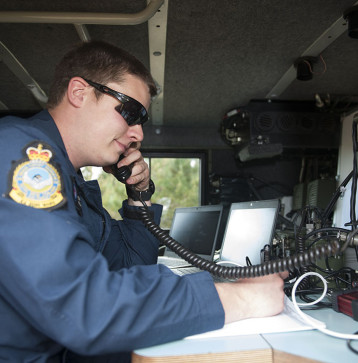
Electronics Technician (Aviation)
Skip to section:
About the role Career progression and training Salary and benefits Entry requirementsTravel the world and work on our expanding fleet of aircraft, learning how to maintain and repair the complex electronics systems that keep them flying. On any given day you could find yourself in the hangar on base, out on the flight line or in the field working on working on aviation systems, navigation, radios and conducting specialised electronics work.
- ServiceAir Force
- SpecialisationEngineering and Technical Trades
- LocationVaried
-
Starting Trade Training$64,177


About the role
As an Electronics Technician you will have the opportunity to work with modern electronic systems and a limited number of simple mechanical systems fitted to military aircraft. You will carry out all aspects of equipment installation, testing, troubleshooting, maintenance and repair. Whether you’re finding and repairing faults in aircraft on operations overseas, or working with our specialist equipment at maintenance facilities on base, being an Electronics Technician is an exciting and challenging role.
Job on base
As an Electronics Technician, you will work on base, at either an operational flying Squadron or a Maintenance Bay. As you advance through your career and get promoted there are further opportunities for employment within the Air Force.
Squadron duties
RNZAF flying squadrons are the focus of aircraft operations and, as part of a ground crew, you will be responsible for aircraft maintenance, fault finding, servicing, receiving and dispatching aircraft for flying tasks. Maintenance duties include the installation and removal of components, and conducting the operational checks and servicings to ensure that aircraft systems are fully serviceable for the next flight.
You will also complete routine maintenance when an aircraft reaches a prescribed number of flying hours. Before the aircraft can fly again it must be intensively cleaned, inspected, tested, components replaced and the aircraft fully reassembled. The technology used in the aviation industry is ever changing and you’ll be required to operate a wide range of test equipment. This includes computer software to assist with maintenance checks, ground running of aircraft avionic systems and the rectification of avionic, software and network faults.
Maintenance bay duties
When not working with a squadron, Electronics Technicians work in the specialised maintenance bays. Here, avionic components are tested, repaired and returned to service to meet flying squadron demands. Your duties include inspecting components returning from overseas repair, loading of software and as necessary, developing new systems or equipment for testing electronic components.
Job on deployment
When squadron aircraft deploy overseas for routine flights, peacekeeping, disaster relief or military operations, Electronic Technicians are part of the attached maintenance team to service and repair the aircraft. You may be responsible for ensuring all the correct tools and spare parts are brought along on the deployment, setting up a computer network for computerised maintenance recording at the deployed location, and liaising with foreign military or civilian personnel for equipment to support maintenance tasks. Operational environments can be widely varied providing new challenges on every deployment.
Bailey gives us a run down on how his team of maintenance personnel keep C-130H Hercules aircraft ready to fly.
Career progression and training
Career progression
Basic Training
Job Training
Ongoing training
Specialist Training
As part of primary trade training, you will complete courses covering working in the aeronautical environment and providing you with basic trade skills and knowledge. After these initial training courses, you will be posted to one of the other Air Force bases to use this trade knowledge and practise these skills for approximately 15 months. Once you have gained this practical experience you will return to Woodbourne for advanced trade training that will fully qualify you as an Electronics Technician, and you will be posted to a Squadron or a Bay.
As you gain experience, you will be promoted and given greater responsibilities of managing aircraft maintenance, associated equipment, and personnel. Duties can include leading personnel, supervising teams performing repair work, instructing junior technicians, technical administration and engineering design roles. You will receive leadership and management training to perform your duties effectively.
Once you've completed your trade training, you can apply for the specialist role of Non Destructive Testing (NDT). NDT is the ability to test aircraft structures for defects without dismantling the structure. This specialisation involves using modern inspection methods, such as Ultrasonics and Infrared Thermography to look ‘inside’ aircraft structure. This skill is becoming more important as our aircraft evolve around composite structures (glass fibre, carbon fibre and Kevlar) rather than the traditional aluminium structure.
Electronics Technicians also have the opportunity to deploy on Royal New Zealand Navy ships to support seaborne helicopter operations.
Upon successful enlistment into the Air Force you will be posted to RNZAF Base Woodbourne (near Blenheim) for your Recruit Course. Here you will do 12 weeks of basic military training to find out if you’ve got what it takes to be in the Air Force, and learn various subjects including:
- Organisation and Administration
- RNZAF Customs and Protocol
- Drill and Parades
- Military Field Skills and Weapon Training
- First Aid, and Search and Rescue Techniques
- Physical Fitness
- Teamwork and Self Discipline
PRIMARY TRADE TRAINING
Aeronautical Engineering Fundamentals Course
After your Recruit Course, you will complete a full-time 20-week Aeronautical Engineering Fundamentals Course. This covers core knowledge and skills for aeronautical engineering, including:
- Construction materials
- Science
- Workplace safety
- Tools and machinery
- Maintenance practices
- Maintenance processes
Avionics Mechanics Course
This 45-week course covers:
- Airworthiness Policy
- Introduction to Aircraft and Avionic Systems
- Avionic Principles
- Avionic Systems including:
- Avionic Integration and Display Systems
- Aircraft Electrical Power Systems
- Aircraft Lighting Systems
- Aircraft Communication Systems
- Electromagnetic Environmental Effects (E3) Principles
- Avionic Mission Systems
- Aircraft Surveillance Systems
- Aircraft Navigation Systems
- Aircraft Auto Flight Systems
- Aircraft Indicating and Recording Systems
- Avionic Repair Skills including:
- Interpreting Aircraft Electrical Servicing Diagrams
- Using Avionic Test and Measuring Equipment
- Servicing Aircraft Electrical Wiring Interconnect Systems (EWIS)
- Avionic Ancillary Systems
- Operating Level Maintenance and Routine Servicing
- Technical Administration
- Dangerous Air Cargo Awareness
- Human Factors
During this course, you will also receive theoretical and practical training on the principles of operation of fixed and rotary wing aircraft, their components and systems. Training covers the inspection, fitting/ removal and maintenance of aircraft components, and provides an overview of aircraft structures, environmental control systems, hydraulics, fire protection, powerplant, propulsion and landing gear. You’ll be instructed on the use of maintenance documents and engineering publications.
On-the-job training
After graduating from the Avionics Mechanics Course as a junior Electronics Technician (AVMECH), you will be posted to technical units for just over a year. With the support of your Training Manager, you will consolidate your skills and knowledge with on-aircraft work experience. You'll complete your workbook by working across maintenance bays and gaining experience with different electronic components.
ADVANCED TRADE TRAINING
Avionics Technician Course
Once you have finished your on-the-job training, you will be posted back to Woodbourne to complete a 12 week Avionics Technician which includes:
- Technical Administration
- Avionics Maintenance Skills
- Avionics Systems Maintenance including:
- Maintaining Aircraft Electrical Power Systems
- Maintaining Aircraft Communication Systems
- Maintaining Aircraft Surveillance Systems
- Maintaining Aircraft Navigation Systems
- Maintaining Aircraft Electrical Wiring Interconnect Systems
- Avionic Component Maintenance
- Human Factors in Aircraft Maintenance
- Engineering Technical Administration
Once completed, you will be eligible to apply for a New Zealand Certificate in Aircraft Servicing level 3 (after around two years) and a New Zealand Certificate in Aeronautical Engineering (Applied Skills) level 4 after around four years.
After primary and advanced trade training, a large variety of post-graduate training and experiential opportunities exist for further professional development. This includes specialisation training in technologies or aircraft systems, and generalist training where you can advance your knowledge in other technical or non-technical areas.
Specialist technical training depends on where you want to take your career. It can include aircraft replacement/upgrade project roles, avionic research, design and development roles, pursuing specialist technology (such as E3, software & technical support), instructor roles and technical management roles.
Non-technical training can include Defence Force management and leadership training or sponsored tertiary study through NZ universities or polytechnics.

Salary and benefits
Careers in the Air Force are well-rewarded, as well as being diverse and exciting. As you become more experienced and move up through the ranks, gaining additional skills and qualifications, you will see your salary rise accordingly.
$50,597
Under Initial Training
$64,177
Starting Trade Training
$129,061
Future Potential Earnings
Figures updated on July 1st 2023
Benefits and allowances
Earn a competitive salary while training or learning your trade, along with additional allowances for time spent in the field, at sea, overseas, or deployed on operations.
In addition to salary and allowances, other benefits of joining the New Zealand Defence Force include:
Access to your Service marae or tūrangawaewae
Sponsored tertiary study programmes at all levels
Free access to gyms and swimming pools on camp and bases
Opportunities to travel
Free and subsidised medical and dental care
Subsidised food and accommodation on camps and bases
Free and subsidised insurance cover
Help to buy a home and save for retirement
Entry requirements
Basics
Education
Fitness and medical
Citizenship
Period of Service
- You must be at least 17 years of age.
- Meet the citizenship & security requirements to gain SV security clearance for this trade.
Minimum: NCEA Level 2 certificate.
Find out more about the NCEA levels and certificate requirements
- You must be medically fit for service.
- Colour perception restrictions may apply.
There are strict citizenship and security requirements to gain the required SV security clearance for this trade.
Your training is some of the most thorough and advanced in the world. Once you have graduated as a Communications and Information Systems Technician, you’ll be contractually obliged to spend another two years in the Air Force.

Ready to start your Air Force career?
Other jobs you might like
You can also browse jobs by specialisation to narrow down your search.

Applications Open

Applications Open

Applications Open
